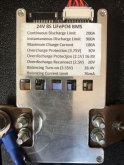Things can go wrong and for protecting the cells when that happens, I’m not questioning the value/need of a BMS.
The first 8S 24V LiFePO4 battery I built has a pedestrian 200A 6S BMS I picked up for under $40.
Any time a cell strays up to 3.75V it’ll shut off the battery.
Any time a cell frond below 2.5V, it’ll shut off the battery.
Above 3.55V it’ll ‘balance’ with a very modest current of 78mA.
But it has no temperature compensation, is not programmable, and is really just there as a failsafe in case something goes wrong.
Charge voltages will be programmed into the MPPT charge controller.
Discharge will be limited by the inverter which cuts off before 20V (2.5V/cell) and also has a SOC sensor and can be programmed to shut off at 10~ (for example).
I’m now planning a 2nd 280Ah 24V LiFePO4 battery and considering whether there are any fancier features I really need from a higher-end BMS or I can stick to my strategy of just spending as little $s as possible on the basics...
The first 8S 24V LiFePO4 battery I built has a pedestrian 200A 6S BMS I picked up for under $40.
Any time a cell strays up to 3.75V it’ll shut off the battery.
Any time a cell frond below 2.5V, it’ll shut off the battery.
Above 3.55V it’ll ‘balance’ with a very modest current of 78mA.
But it has no temperature compensation, is not programmable, and is really just there as a failsafe in case something goes wrong.
Charge voltages will be programmed into the MPPT charge controller.
Discharge will be limited by the inverter which cuts off before 20V (2.5V/cell) and also has a SOC sensor and can be programmed to shut off at 10~ (for example).
I’m now planning a 2nd 280Ah 24V LiFePO4 battery and considering whether there are any fancier features I really need from a higher-end BMS or I can stick to my strategy of just spending as little $s as possible on the basics...



